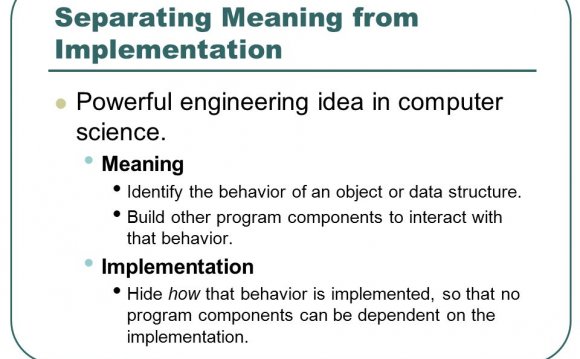
The essence of abstractions is preserving information that is relevant in a given context, and forgetting information that is irrelevant in that context.
In computer science, abstraction is a technique for managing complexity of computer systems. It works by establishing a level of complexity on which a person interacts with the system, suppressing the more complex details below the current level. The programmer works with an idealized interface (usually well defined) and can add additional levels of functionality that would otherwise be too complex to handle. For example, a programmer writing code that involves numerical operations may not be interested in the way numbers are represented in the underlying hardware (e.g. whether they're 16 bit or ), and where those details have been suppressed it can be said that they were abstracted away, leaving simply numbers with which the programmer can work. In addition, a task of sending an email message across continents would be extremely complex if you start with a piece of optic cable and basic hardware components. By using layers of complexity that have been created to abstract away the physical cables, network layout and presenting the programmer with a virtual data channel, this task is manageable.
Abstraction can apply to control or to data: Control abstraction is the abstraction of actions while data abstraction is that of data structures.
- Control abstraction involves the use of subprograms and related concepts control flows
The same abstract definition can be used as a common interface for a family of objects with different implementations and behaviors but which share the same meaning. The inheritance mechanism in object-oriented programming can be used to define an abstract class as the common interface.
The recommendation that programmers use abstractions whenever suitable in order to avoid duplication (usually of code) is known as the abstraction principle. The requirement that a programming language provide suitable abstractions is also called the abstraction principle.
Rationale[edit]
Computing mostly operates independently of the concrete world: The hardware implements a model of computation that is interchangeable with others. The software is structured in architectures to enable humans to create the enormous systems by concentration on a few issues at a time. These architectures are made of specific choices of abstractions. Greenspun's Tenth Rule is an aphorism on how such an architecture is both inevitable and complex.
A central form of abstraction in computing is language abstraction: new artificial languages are developed to express specific aspects of a system. help in planning. can be processed with a computer. An example of this abstraction process is the generational development of programming languages from the machine language to the assembly language and the high-level language. Each stage can be used as a stepping stone for the next stage. The language abstraction continues for example in scripting languages and domain-specific programming languages.
Within a programming language, some features let the programmer create new abstractions. These include subroutines, modules, polymorphism, and software components. Some other abstractions such as software design patterns and architectural styles remain invisible to a programming language and operate only in the design of a system.
Some abstractions try to limit the breadth of concepts a programmer needs by completely hiding the abstractions that in turn are built on. The software engineer and writer Joel Spolsky has criticised these efforts by claiming that all abstractions are — that they can never completely hide the details below; however this does not negate the usefulness of abstraction. Some abstractions are designed to interoperate with others, for example a programming language may contain a foreign function interface for making calls to the lower-level language. Data abstraction is the separation between the specification of data object and its implementation.
Programming languages[edit]
INTERESTING VIDEO











